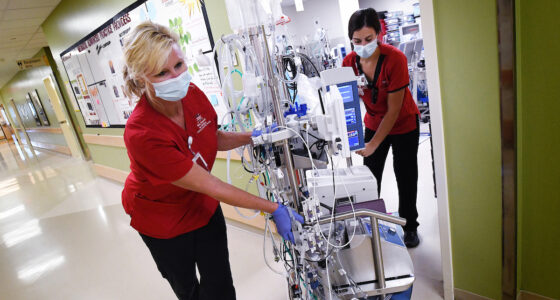
Extracorporeal membrane oxygenation (ECMO) is a highly specialized life-saving treatment that gives your child’s heart and lungs time to rest, heal, and return to normal function when they are experiencing severe heart and/or lung failure from an illness or injury. ECMO is a procedure that uses a special machine to take over the workload of the lungs and heart by removing carbon dioxide (CO2) from the blood, adding oxygen to the blood, and pumping the blood around the body.
While ECMO does not cure the illness causing distress, it can stabilize your child’s condition. By reducing the strain put on the lungs and heart, ECMO can give your child time to recover so that his or her doctors can provide other treatments for the underlying condition. For example, ECMO may be used to stabilize babies who have a congenital diaphragmatic hernia or Hypoplastic Left Heart Syndrome, so they can undergo surgical repair.
What to Expect
What to Expect
After trying other treatments, the Riley medical team may decide to start ECMO treatment. ECMO involves the use of a heart and lung bypass machine, like the type of machine used on adults during heart surgery. However, it is set up to use for several days rather than several hours.
ECMO involves inserting one or more special tubes called cannulas into your child’s blood vessels, normally at the neck or in the groin area at the top of the leg. There are two cannulas: one transports deoxygenated blood (blood that is not carrying oxygen), and the other transports oxygenated blood. In some cases, one single tube may contain both cannulas.
Using a combination of gravity and a special pump, one cannula moves deoxygenated blood out of the body and into a special machine that removes carbon dioxide and adds oxygen—just as the lungs normally do. The blood is warmed to body temperature throughout the process. Then the other cannula carries it back into your child’s body where it can then circulate and provide fresh oxygen to the body tissues.
Key Points to Remember
Key Points to Remember
- Extracorporeal membrane oxygenation (ECMO) is a highly specialized life-saving treatment for children experiencing heart and/or lung failure.
- When a child has a respiratory or cardiac condition that does not improve after receiving other treatments, the care team may use ECMO.
- ECMO may be used as a treatment or to stabilize your baby before undergoing other treatments or surgery.
- ECMO involves the insertion of one or more special tubes called cannulas that carry the blood to and from a machine that simulates the normal functions of the lungs.
- In some cases, ECMO can act as both the lungs and the heart, helping to provide oxygen to the blood and pump it throughout the body.
Related Stories
Related Stories

ECMO offers hope and peace to families
Advanced life support gives critically ill patients a chance to heal.
Continue reading
She almost lost her boy, but the stars aligned that January night
So many times, someone could have said, “No, we can’t do that.” Instead, teams from three hospitals said “yes,” and a 15-year-old boy is alive because of it. Read how Riley and Methodist worked together to save a patient who was clinging to life at an Evansville hospital.
Continue reading


